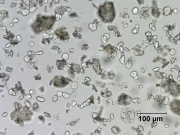Difference between revisions of "Ginger"
Jump to navigation
Jump to search
(username removed) |
|||
| Line 2: | Line 2: | ||
== Description == | == Description == | ||
| − | A natural yellow lake [ | + | A natural yellow lake [[pigment]] prepared from the dried roots of the ginger plant (''Zingiber officinale''). Ginger is native to Southeast Asia and has been used as a spice, [[essential oil]], and colorant since ancient times in India and China. It was brought to Europe in the 1st century CE and is currently cultivated in most tropical and subtropical countries. |
== Synonyms and Related Terms == | == Synonyms and Related Terms == | ||
Revision as of 08:15, 16 January 2014
Description
A natural yellow lake Pigment prepared from the dried roots of the ginger plant (Zingiber officinale). Ginger is native to Southeast Asia and has been used as a spice, Essential oil, and colorant since ancient times in India and China. It was brought to Europe in the 1st century CE and is currently cultivated in most tropical and subtropical countries.
Synonyms and Related Terms
Zingiber officinale; gingembre (Fr.); gengibre (Port.)
Additional Images
Authority
- R.D. Harley, Artists' Pigments c. 1600-1835, Butterworth Scientific, London, 1982
- The Merck Index, Martha Windholz (ed.), Merck Research Labs, Rahway NJ, 10th edition, 1983 Comment: entry 4430
- The American Heritage Dictionary or Encarta, via Microsoft Bookshelf 98, Microsoft Corp., 1998
- Encyclopedia Britannica, http://www.britannica.com Comment: "Ginger." Encyclopædia Britannica. 15 July 2004 .

